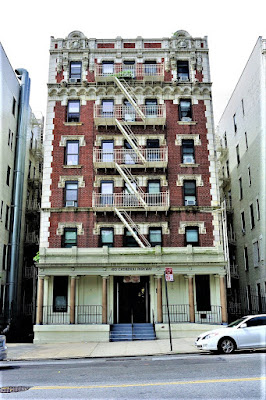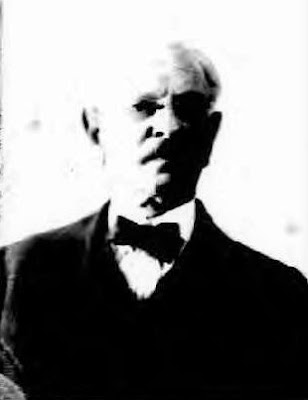Cornell Woolrich appears to have lived a retiring and isolated existence on the whole, being more an observer of life than an experiencer of it. "I have lived in hotels most of my life," he recalled at the age of forty, explaining why he knew so little about the real world. "Fortunately," he added, "I am a writer of imagination."
 |
| Blink and you'll miss him one-eyed Victorian-era professional safecracker Thomas "Blink" Kelly in 1886, when he was 33 years old |
Of course Cornell Woolrich's Edgar-award winning biographer has been telling us for for decades now that when he briefly lived out in Hollywood in the late Twenties and early Thirties, Woolrich led a "homosexual life of the most furtive and sordid variety." Despite the fact that his contemporaries over and over again described him as pale, fragile, nervous and timid, the proverbial 98-pound weakling at the beach (except that he weighed about 122), we are to believe that at midnight Woolrich, like some sort of Sin-derella, donned a "sailor suit" he kept in a locked suitcase and tripped down to the docks in LA, where he went "prowling...in search of partners."
If this is actually true I would expect that Woolrich would have gotten beaten up more than a few times, if not arrested at some point. Still, I remain dubious of the veracity of this claim. (See my forthcoming article on the subject; I'll keep you posted.)
Even if this story is bunkum, however, Woolrich did at least know people who lived life, as it were. There was his Mexican father Genaro Woolrich, a handsome ladies man who apparently had sole custody of Cornell for several years around the time of World War I and took the boy with him on engineering jobs in several countries--although "Con" seems mostly to have gotten dumped in hotel rooms.
Eventually young Woolrich after about a decade in Mexico returned to the United States for good in 1917 to live with his mother Claire at her father George Tarler's opulent turn-of-the-century house in Manhattan. In 1920 the other denizens of the house besides Woolrich were, besides his mother and grandfather
his distinguished uncle George Cornell Tarler, a lawyer and diplomat
his aunts Estelle, Lillian and Olga
Estelle's Cuban husband Emilio Manuel Garcia, an electrical engineer
the widowed Lillian's young son Archie Cornell MacBain.
There was also a live-in Irish maid. Another uncle, Irving Cornell Tarler, a salesman with The Texas Company, aka Texaco, had just married and moved out of the house, settling with his wife at the affluent Westchester County city of Scarsdale.
For some reason--wishful thinking, perhaps--Woolrich in his fragmentary memoir Blues of a Lifetime portrayed himself as living at his grandfather's house with just his grandfather, his mother and one unmarried aunt; and this story has been accepted for decades, no one until now ever having checked the census records, evidently. In truth there were a bunch of people, mostly family members, milling around that house when he lived there. Indeed, it's rather like the cast of characters in an S. S. Van Dine mystery.
 |
| The Park Avenue apartment building where George Cornell Woolrich moved in the late 1920s looks like the setting for S. S. Van Dine's The Garden Murder Case (1935) |
After patriarch George Tarler's death in 1925, however, the family began finally to scatter. Woolrich himself, having precociously published two novels, in 1927 moved out to LA, like many another writer before and after him, to try his luck at screenwriting.
His uncle George married a well-off widow and moved into a ritzy Park Avenue apartment valued at $100,000 in 1930, or about 1.7 million dollars today (see left). Estelle and Emilio moved out, perhaps to exotic New Jersey, while Lillian and her son Archie stayed on, along with Claire.
Around 1932 the Tarler house was sold and Claire with Cornell, who had returned to New York in 1931 after the quick collapse of his LA marriage, moved into an apartment at the Hotel Marseilles, where the pair lived for a quarter-century until Claire's death in 1957. Here Woolrich wrote the vast bulk of his crime fiction.
 |
| Hotel Marseilles, where Cornell and Claire lived for a quarter century. Here Cornell made the magical mystery tour happen--on paper |
During the Thirties Woolrich maintained enough contact with his family members that he served as one of the two witnesses at the 1938 marriage of his cousin Archie, who was twelve years younger than he, to a waitress named Dorothy Lynch. Archie, who was rather heftier than Cornell (5'10" and 175 pounds with brown hair and brown eyes to 5'9" and 122 pounds with blue eyes and brown hair), married a second time in 1943 and then served in the navy for the duration of World War Two.
During this time Archie's mother Lillian and her sister Olga shared a rather more modest apartment than their rich brother's at Morningside Heights. Archie, who unlike Cornell did not go to college, managed a movie theater, leading me to wonder whether the frugal (aka miserly) Cornell ever cadged tickets from him. In 1940 Archie and Dorothy lived at an apartment on Cathedral Parkway in Morningside Heights.
 |
| apartment building where Woolrich's aunts Lillian and Olga lived |
The photos give you some idea of Cornell's New York, at least as lived in by himself and his Tarler relations, looked like. I like to think Archie and Dorothy might have inspired some of the young couples in Cornell's crime fiction as well, but who knows? Presumably neither was compelled by capricious fortune to turn to crime, as so many of the characters in his fiction are.
However, Woolrich's grandfather George Tarler did encounter a well-known New York crook in earlier, Victorian days, way back in 1883. Said crook's name was Thomas "Tommy" Kelly, who also went by the alias Thomas Jordan and was nicknamed "Blink" and "Blinky" Kelley, on account of, as you will have guessed, his having lost his right eye.
A member of Patsey Carroll's gang, Blink Kelly was a burglar and safecracker by occupation; and when in 1883 he was accused, at the age of twenty-eight, of participating in a burglary of George Tarler's import/export business at 7 Burling Slip in Manhattan, which did a great deal of trade in gold and silver jewelry, watches, etc., he already had a criminal record, having been convicted of grand larceny and sentenced to prison terms most recently in 1879 and 1880.
 |
| apartment building where Archie Cornell MacBain lived with his waitress wife Dorothy in 1942 |
When he was processed at Sing Sing Prison on the day before Christmas in 1880, Blink was recorded as being age 25 and employed as a waiter, with a dark complexion, hazel eye and brown hair. He was Catholic, of moderate habits and a user of tobacco. On his slim but "regular-featured" head he had scars and a prominent dimpled chin. He had a dot inked on his left hand near the thumb as well as yet more scars.
Blink was arrested for the Tarler job when he was socializing Martin Reeve's saloon at 38 Forsyth Street, a notorious thieves den, in the company of gang leader Patsey Carroll, John Talbot, alias the Hatter, Clarkey Carpenter and William Landendorf (Dutch Harmon's brother). Quite a crew!
While Carroll and Talbot were convicted of the theft of about $35,000 worth of goods (in modern value) and sentenced to prison terms of four years apiece, however, Blink went free.
Was he innocent or just cleverer at evading justice? The night watchman at Burling Slip reported having noticed, on the night of the burglary, a man under a lamppost reading a newspaper, whom he later identified to the police as Blink. Sounds like he was scouting the joint for accomplices!
When he wasn't cracking safes, Blink busied himself intimidating voters and committing election fraud on behalf of various political factions in the city; for this work, he was dubbed by the press the "Terror of the Fourteenth Ward." Pretty impressive for someone who stood 5'8" and 130 pounds! I'm guessing he got those scars for good reasons.
 |
| 152 Rivington street where Blink Kelly resided when he was arrested |
So did Blink reform after his escape from the law in 1883?
Well, apparently so, at least for a while, for he started cracking safes on stage. When the hit melodrama The Stowaway premiered on Broadway in 1888, the play's canny producer decided to hire two real criminals to perform the safecracking scene, one of whom was our boy Blink, who was born to have been played on screen at some point by Daniel Day Lewis.
The professional cracksmen entered the stage in masks and quickly got down to business, boring holes in the safe and drawing powder down about the door with the blower, And then:
[A] big carpet was rolled in front of the safe, the fuse was lighted and puff, bang, the door of the safe was blown clean out on the carpet.
 |
| Cornell Woolrich's Russian Jewish grandfather, George Tarler a couple of years before his death in 1925. He migrated to the US in 1869 at the age of 20. |
"They are professionals and no mistake. The best thing of all, though, is the neat businesslike way in which they get off the stage when discovery comes. That is a point the audience overlooks, but the crooks make tracks as natural as life, leaving their tools and their inexperienced pals behind them."
It's like The Asphalt Jungle, only six decades earlier! I hope Cornell Woolrich got to hear the tale of the theft many years afterward from his grandfather, who was only seven years older than Blink, whose own final fate remains unknown. George Tarler died in 1925 at the age of 76, just as his grandson Cornell was on the cusp of a very unusual career, albeit one where, I believe, all the crime was imaginary.
For more on Blink Kelly, see this page at the fascinating Professional Criminals of America--Revised blog.
 |
| Burling Slip in lower Manhattan, where George Tarler's import/export business was located in the nineteenth century |

Too bad there is no picture of the family mansion.
ReplyDeleteWas it destroyed?
Supposedly the building standing there was built in 1900 so that should be it. The Google maps pic does not give a clear view, however. Someone in NYC really should get a photo.
Delete